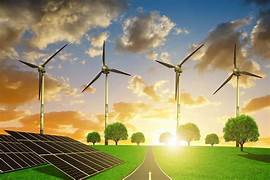The Future of Renewable Energy: A Path to Sustainable Development
March 23, 2025 2025-03-21 10:09
The Future of Renewable Energy: A Path to Sustainable Development
Renewable energy refers to power derived from sources that are naturally replenished on a human timescale, such as sunlight, wind, rain, tides, waves, geothermal heat, and more. Unlike fossil fuels such as coal, oil, and natural gas, which take millions of years to form, renewable energy sources are abundant and can be replenished relatively quickly, making them a cornerstone for a sustainable future. The push for renewable energy is motivated by several factors, including the desire to reduce the environmental impact of energy production, mitigate climate change, and promote energy security and independence.
As the world grapples with the looming threat of climate change, it is clear that transitioning to renewable energy is no longer just an option—it is an imperative. This article delves into the role of renewable energy in creating a sustainable future, explores the various types of renewable energy, and examines the challenges and opportunities in adopting these energy solutions.
The Importance of Renewable Energy
The global energy demand is rapidly increasing, driven by population growth, industrialization, and technological advancements. Traditionally, fossil fuels have met the majority of this demand, but the environmental and social consequences of continued reliance on them are undeniable. The burning of fossil fuels releases greenhouse gases (GHGs) such as carbon dioxide (CO2), contributing significantly to global warming and climate change. According to the International Energy Agency (IEA), the energy sector accounts for approximately 73% of global CO2 emissions.
Renewable energy offers a solution to this problem, providing a clean and sustainable alternative to fossil fuels. By transitioning to renewable energy sources, societies can drastically reduce their carbon footprint and mitigate the impacts of climate change. Furthermore, renewable energy can contribute to energy security by diversifying energy sources and reducing dependence on imported fossil fuels.
Types of Renewable Energy
Renewable energy comes in many forms, each with its unique advantages and challenges. The most common types of renewable energy are solar, wind, hydroelectric, geothermal, and biomass energy.
1. Solar Energy
Solar energy is derived from the sun’s radiation, which can be converted into electricity or heat. Solar power is the most widely available and rapidly growing renewable energy source. Solar panels (photovoltaic cells) capture sunlight and convert it into electricity, while solar thermal systems use sunlight to heat water or air for residential or industrial use.
Solar power has experienced significant technological advancements in recent years, making it more affordable and efficient. In many regions, the cost of solar electricity is now lower than that of conventional electricity generated from fossil fuels. Solar energy is also highly scalable, making it suitable for applications ranging from small residential rooftops to large solar farms.
However, solar energy is intermittent—it depends on sunlight, which is not available at night and is often less abundant on cloudy days. To overcome this, solar energy systems can be combined with energy storage solutions such as batteries or connected to the grid, where excess electricity can be stored for later use.
2. Wind Energy
Wind energy is harnessed using wind turbines that convert the kinetic energy of moving air into electricity. Wind power is one of the fastest-growing renewable energy sectors globally, with wind farms being built in both onshore and offshore locations. Wind power has a significant advantage in terms of scalability, from small turbines for residential use to large offshore wind farms capable of powering entire cities.
One of the key benefits of wind energy is its low operating costs once the turbines are installed. However, like solar energy, wind power is intermittent—it depends on wind speed and can be variable from one location to another. In some areas, wind speeds may not be consistent enough to rely solely on wind energy. Yet, advances in turbine technology have made it possible to capture wind energy even at lower speeds, and storage solutions like batteries and pumped hydro storage are being developed to address the intermittency of wind power.
3. Hydroelectric Energy
Hydropower, or hydroelectric energy, uses the energy of flowing or falling water to generate electricity. Dams are typically constructed on rivers to store water in reservoirs. When the water is released, it flows through turbines, generating electricity in the process. Hydroelectricity accounts for the largest share of renewable energy generation globally, with large-scale hydropower plants providing a significant portion of the world’s electricity.
Hydropower has several benefits, including a long track record of reliability and the ability to generate large amounts of electricity. Additionally, hydropower plants can provide energy storage through pumped storage systems, where excess energy is used to pump water to higher elevations, allowing it to be released and generate electricity when demand is high.
However, large hydroelectric projects can have significant environmental and social impacts, such as the displacement of communities and disruption of local ecosystems. Furthermore, many of the best locations for large hydroelectric dams have already been developed, limiting the potential for future growth in this sector.
4. Geothermal Energy
Geothermal energy is derived from the heat stored beneath the Earth’s surface. This heat can be harnessed to generate electricity or to provide direct heating for residential and industrial applications. Geothermal power plants use steam or hot water from deep underground reservoirs to drive turbines connected to electricity generators.
Geothermal energy is highly reliable, as the heat beneath the Earth’s surface is constant and can be accessed 24/7. Additionally, geothermal power plants have a small environmental footprint and produce very little GHG emissions. However, geothermal energy is location-specific—it is most viable in areas with significant tectonic activity, such as along the Pacific Ring of Fire, and may not be available in all regions.
5. Biomass Energy
Biomass energy is derived from organic materials such as wood, agricultural residues, and waste products. These materials can be burned directly to produce heat or converted into biofuels (such as ethanol and biodiesel) to replace gasoline and diesel. Biomass can also be used to generate electricity in power plants.
One of the key advantages of biomass energy is its potential to reduce waste by converting it into usable energy. Furthermore, biomass can provide a renewable alternative to fossil fuels in sectors such as transportation. However, the environmental benefits of biomass are debated. While it can be considered renewable, the combustion of biomass still releases CO2, and the large-scale cultivation of bioenergy crops can lead to land-use changes and potential deforestation.
Challenges in Adopting Renewable Energy
Despite the many benefits of renewable energy, there are several challenges to its widespread adoption.
1. Intermittency and Storage
As mentioned earlier, renewable energy sources such as solar and wind are intermittent, meaning they do not always produce power when it is needed most. This can create challenges for grid stability and reliability, especially in regions with high levels of renewable energy penetration.
To address this issue, energy storage technologies such as batteries, pumped hydro storage, and compressed air energy storage are being developed. These technologies allow excess energy to be stored and used when renewable power generation is low. However, the cost of energy storage remains a barrier to widespread adoption, as the technologies are still developing and can be expensive.
2. Infrastructure and Grid Integration
Integrating renewable energy into the existing energy grid can be complex. Many grids were designed to handle centralized, fossil fuel-based power generation, and transitioning to a decentralized system with varying levels of renewable energy generation requires significant upgrades to infrastructure.
Grid flexibility is crucial to accommodate the fluctuating nature of renewable energy. Smart grids, which use digital technologies to monitor and manage energy use more efficiently, are being developed to facilitate this transition. However, the necessary infrastructure upgrades are costly and require substantial investment from governments, utilities, and the private sector.
3. Political and Economic Barriers
The transition to renewable energy is often hindered by political and economic barriers. Fossil fuel industries have significant political influence in many countries, and vested interests may resist the shift to cleaner energy sources. Furthermore, the upfront cost of renewable energy technologies, particularly in developing countries, can be a barrier.
While renewable energy technologies are becoming more affordable, the initial investment can still be prohibitive, especially in regions with limited financial resources. Governments and international organizations must play a crucial role in providing incentives, subsidies, and financing mechanisms to encourage the adoption of renewable energy.
Opportunities in Renewable Energy
Despite the challenges, there are significant opportunities in renewable energy. The renewable energy sector has the potential to create millions of jobs worldwide, from manufacturing and installation to research and development. This job creation can contribute to economic growth, particularly in developing countries.
Moreover, as renewable energy technologies continue to improve and become more cost-effective, the economic case for transitioning to renewable energy becomes stronger. Increased investment in renewable energy can lead to greater energy independence, reduced energy prices, and a cleaner, more sustainable energy future.
Conclusion
The transition to renewable energy is essential for combating climate change, promoting sustainable development, and securing a cleaner energy future. While there are challenges to overcome, such as intermittency, storage, and infrastructure integration, the opportunities provided by renewable energy are immense. By investing in clean energy technologies and supporting policies that encourage their adoption, we can ensure a sustainable, prosperous future for generations to come. The time for action is now, and the path forward is one of innovation, collaboration, and determination.
Related Posts
The Future of Renewable Energy: A Path to Sustainable Development
March 23, 2025 2025-03-21 10:09Popular Tags






























